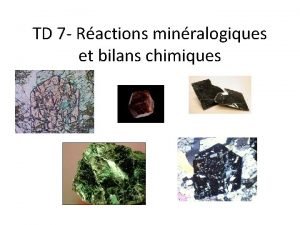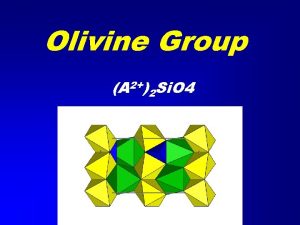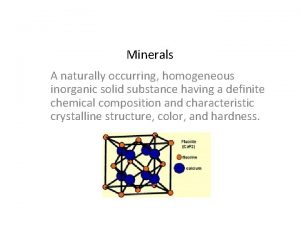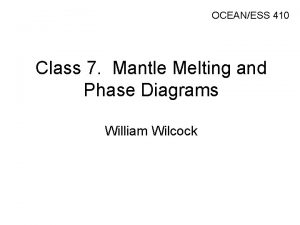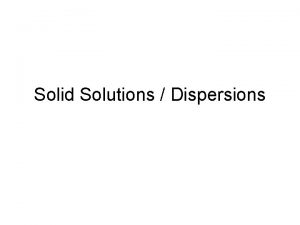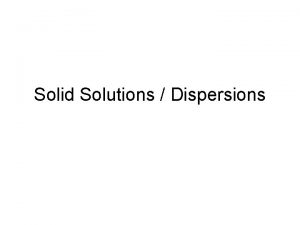Solid solutions Example Olivine Mg Fe2 Si O








- Slides: 8

Solid solutions Example: Olivine: (Mg, Fe)2 Si. O 4 two endmembers of similar crystal form and structure: Forsterite: Mg 2 Si. O 4 and Fayalite: Fe 2 Si. O 4 à isomorphism complete mixing range exists between forsterite and fayalite (isomorphous mixture) à Mg/Fe ratio is variable, but (Mg+Fe)/Si ratio is constant! Olivine is a solid solution between these two endmembers! (like a solution, olivine is “homogeneous” over the entire range of Mg/Fe ratios) Mg 2+ and Fe 2+ substitute for each other in the olivine crystal structure

Solid solutions pure albite melts at 1118 o. C, pure anorthite at 1557 o. C, mixtures are intermediate Melt with 60% anorthite (and 40% albite) cools to 1470 o. C (X) before the first crystals with composition Y appear. These crystals are higher in anorthite than the melt and hence deplete the melt in anorthite (the melt follows X -> K). The older crystals continuously re-equilibrate with the melt until crystallization stops at K. At K, all melt is crystallized and these crystals have composition L (which is the starting composition of the melt).

Solid solutions D C B A pure albite melts at 1118 o. C, pure anorthite at 1557 o. C, mixtures are intermediate Melting plagioclase with 40% anorthite (and 60% albite) starts at ca 1245 o. C (A) and produces melt of composition B. This melt is higher in albite than the solid and hence depletes the solid in albite as melting proceeds (the solid and melt follow A -> C and B -> D, resp. ). At D all solid is melted and turned into a liquid with 40% anorthite and 60% albite (which is the starting composition of the plagioclase).

Eutectic melts D -> E and A -> E are the melting points of the possible diopside + anorthite mixtures For example: Melt with 20% anorthite and 80% diopside cools (M -> N) the first diopside crystallizes at 1350 o. C composition of melt changes (N -> E) at E the melt has 58% diopside and 42% anorthite, anorthite begins to crystallize temperature remains constant until crystallization is complete E = eutectic (temp. ) = lowest temperature at which melt exists in the system E = eutectic composition of a diopside + anorthite melt

Partial melting: a solid (in the mantle a peridotite or in the continental crust a granite, for example) moves above the solidus and starts to (partially) melt. batch melting (equilibrium fusion, equilibrium partial melting): melt and residual solid continually react with each other and reequilibrate at the site of melting until the melt escapes as a single batch of magma (probably applicable to production of felsic melts in the upper and lower continental crust). fractional melting (Rayleigh melting): small amount of melt forms and is instantly removed from the source (probably applicable to production of basaltic melts in the mantle).

Geochemistry-Quiz 2, 11/04/04: 1. What is the difference between LILEs and HFSEs? (give an example of each) 2. How do KD values depend on temperature, pressure, and Si. O 2 content? 3. What is the difference between batch melting and Rayleigh melting? 4. Why is Dr important for magma genesis?

Partial Batch Melting: Homework Assignment 2 CL/C 0 = 1 / [DRS + F(1 -DRS)] CL = C 0 / [DRS + F(1 -DRS)] CL C 0 F DRS = concentration in liquid (partial melt) = concentration in unmelted solid (mantle peridotite) = fraction of melt produced during partial melting = bulk distribution coefficient for the residual solid (peridotite after melt extraction) Calculate the Sr and Yb concentrations in a melt after 3% and 30% partial melting, respectively, of a mantle with 50 ppm Sr and 3 ppm Yb leaving a residuum with a) 40% ol + 20% opx + 20% cpx + 20% plag b) 40% ol + 20% opx + 20% cpx + 20% gt Display the results in a Sr vs. Sr/Yb plot and discuss them !

Partial Melting
